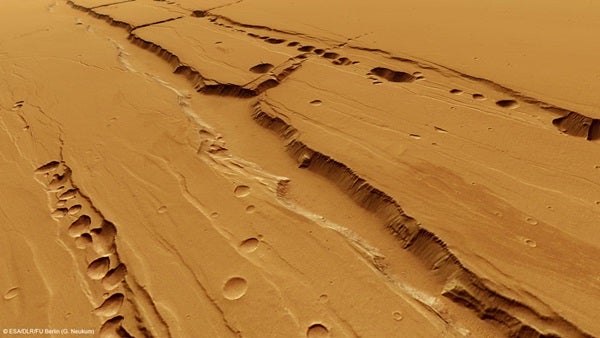The images, taken June 22, 2011, cover Tractus Catena in the Arcadia quadrangle, part of the vast Tharsis region on Mars. This region boasts a number of huge volcanoes, including the three collectively known as Tharsis Montes. To their north sits Alba Mons, also known as Alba Patera, one of the largest volcanoes in the solar system by area and volume.
Tractus Catena sits on its southeastern flank of Alba Mons, and the pit-chains in that region are a series of circular depressions that formed along fracture points in the martian crust.
Pit-chains can have a volcanic origin. Lava streaming from a volcano solidifies on the surface, leaving a molten tube of lava running below.
Once volcanic activity ceases, the tube empties, leaving behind a subterranean cavity. Over time, parts of the roof over the cavity may collapse, leaving circular depressions on the surface. On Earth, recent examples can be seen on the flanks of Kilauea volcano in Hawaii, while on the Moon, Hadley Rille, visited by Apollo 15 in 1971, is believed to have formed in the same way billions of years ago.
Pit-chains also can be caused by strains in the martian crust, which translates into a series of parallel elongated depressions known as grabens, in which pits can form.
But the most dramatic scenario involves groundwater. On Earth, there are clear examples of similar structures in “Karst” regions — after the German name for a region extending from Slovenia to Italy, where this phenomenon was first studied.
Some of Earth’s most famous examples are the network of “cenotes” on the Yucatan Peninsula of Mexico. These deep natural pits form when the surface limestone rocks collapse, exposing the groundwater underneath.
This origin is the most interesting in the context of the search for microbial life on Mars. If there are any cave-like structures associated with the pits, microorganisms could have survived, protected from the harsh surface environment.
Mars landers have measured surface radiation around 250 times higher than that found on Earth, and more than double that experienced by astronauts aboard the International Space Station. Any caves associated with the pit-chains may in future provide a possible refuge for astronauts from the harsh surface radiation.
However they formed, these pit-chains show again just how similar many of the geological processes on Mars are to those on the Earth, and provide interesting targets for future missions.










